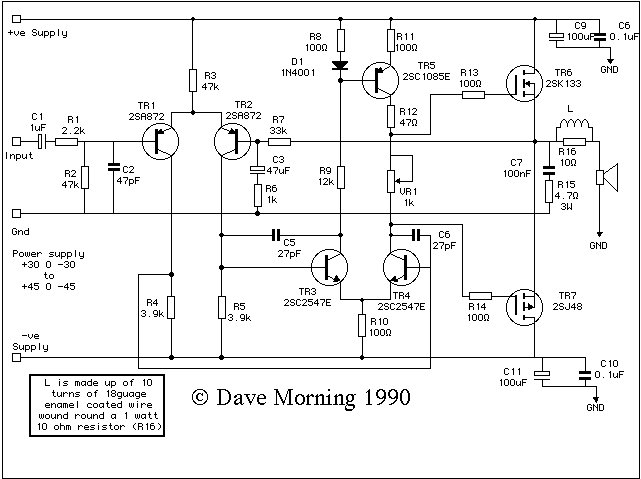

Most musical instrument (i.e., anaerobic guitar) amplifiers still use vacuum tubes, in large part because tube amplifiers saturate slowly, giving a ``warm-sounding'' distortion, while transistor amplifiers cut off sharply, so they have unpleasant high-frequency components in their output.
This is a schematic for the
Mosfet amp. Following are the comments of
the creator David Morning
Dave Morning's gloss:
SUGGESTED TWEAKS:-
The design is based around the Hitachi design and, as such, uses Hitachi
Mosfets and transistors. I believe these are difficult to obtain in the US,
(They're 10 a penny [in the UK]) but IR do a range of Mosfets which should
work fine. The specs for the two are:-
2SK133
Drain-Source voltage Vdsx=120
Gate-Source voltage Vgss=±14
Drain Current Id=7A
Reverse Drain Current Idr=7A
Power Dissipation Pch=100watts
2SJ48
Drain-Source voltage Vdsx=-120
Gate-Source voltage Vgss=±14
Drain Current Id=-7A
Reverse Drain Current Idr=-7A
Power Dissipation Pch=100watts
The IR data book suggests the IRF220 range as a cross reference for the 2SK13X
range so I'd suggest an IRF221. The 2SJ4X is cross referenced as IRF923X range.
I'd suggest IRF9231 as the equivalent.
There's one major fly in the ointment...the pin-outs :-(
Looks like this...
Hitachi IR
o o
drain gate source gate
o o o o
o o
Case=Source Case=Drain
So the drain and source connections are swapped over. Isn't a serious
problem but it will mean some juggling about with the foil routes (good
practical exercise for a student :-) )
The bipolars are much more straight forward. Just make sure that they've got
reasonable Hfe >100, can cope with the full supply and are reasonably
low noise.
V+---------------|100ohms|------------>drive stage supply
| |
TR6drain = 100µF
|
TR6source GND
|
LSpkr----|
|
TR7source
TR7drain
|
-V---------------|100ohms|------------>drive stage -ve supply
|
= 100µF
|
GND